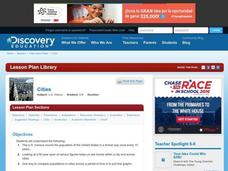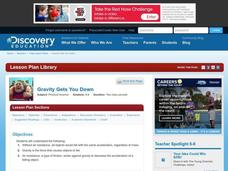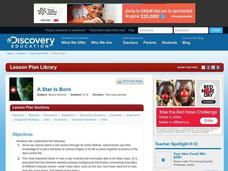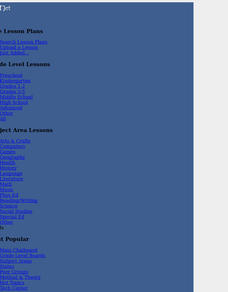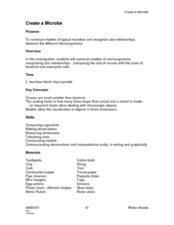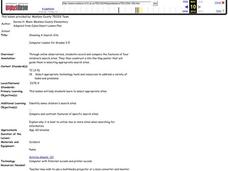Curated OER
Cities
Students examine U.S. Census figures. In this urban centers instructional activity, students compare city populations across the span of 50 years. Students create line graphs based on the data.
Curated OER
Inventor's Workshop
Students explore the six simple machines that are the basis for all mechanical devices. In this physics lesson, students choose one simple machine to research and then find a complex machine it is apart of. Students examine Leonardo...
Curated OER
Eyes in the Sky
Students examine the use of satellites. In this research instructional activity, students discuss the history of satellites and how we use the information today. They will conduct interviews with older adults who have lived in the...
Curated OER
Dangerous Earth
Students view a Dangerous Earth video and research a historic or recent earthquake. In this earthquake lesson students create a piece of are to portray the experience of their particular earthquake.
Curated OER
Cruel Schools
Students survey the climate of their school. In this personal health lesson, students discuss bullying and violence in schools. Students then complete a school climate survey, compile the results, and interpret them. Students write data...
Curated OER
Pumpkin Roll
High schoolers build a machine to roll a pumpkin. In this invention lesson, students work in groups to build a machine, in the classroom, that will roll a pumpkin farther than their classmates machines. The lesson ends with a competition.
Curated OER
Calculating Profits from Selling Virtual Lemonade
Students set up and collect data for a virtual lemonade stand. In this entrepreneurship, economics, and technology lesson, students purchase ingredients, determine costs, and set up a virtual lemonade stand. Students consider weather...
Curated OER
Gravity Gets You Down
Students design an experiment to investigate how objects with different masses fall. In this physics lesson, students predict how these objects will fall in a vacuum tube. They write a report explaining experimental results and conclusion.
Curated OER
Halogens
High schoolers identify the elements that belong to the halogen family on the periodic table. In this chemistry lesson plan, students describe the common characteristics of elements in this group. They research about hydrochloric acid's...
Curated OER
A Star is Born
Students research the life cycle of a star. In this astronomy lesson, students work in groups to research on stage in stellar evolution and report back to the class their findings. They will discuss as a class the order of the stages and...
Curated OER
Lemonade Business
Twelfth graders use all features of Microsoft Excel and Microsoft Power Point to create charts and graphs. They use charts and graphs to make a Power Point Presentation.
Curated OER
Microbes and Our Food
Students investigate foodborne illnesses and involved microbes. They identify major pathogens and then research and explain how they contaminate foods and how people are affected.
Curated OER
Create a Microbe
Learners construct models of microorganisms recognizing size relationships-comparing the size of viruses with the sizes of bacterial and eukaryotic cells. They put into perspective just how small microbes are by comparing the size of...
Curated OER
Future tense
Students explore the function of verbs when considering tense. They read a story that is written in past tense and discuss how to change it to future tense. Students transform a news story from past to future tense.
Curated OER
Sig Fig/Measuring Lab
In this significant figure worksheet, students read six diagrams of a graduated cylinder to the proper number of significant figures. They then go to twelve lab stations and record the proper measurement to the appropriate number of...
Curated OER
Food/Food Borne Illness Scenario
In this food borne illness worksheet, students are given a scenario about guests aboard a cruise ship that get violently ill after a buffet dinner. Students answer 6 questions about the situation, the problem and a possible solution to...
Curated OER
The People of Kansas: Where did they come from and why did they come?
Students review census data to correlate to emigration in Kansas. In this Westward Expansion lesson, students analyze a painting and create definitions for emigration and discuss why people emigrate. Students read and analyze 1855 census...
EngageNY
Drawing a Conclusion from an Experiment (part 1)
Challenge your classes to complete an experiment from beginning to end. Learners make their own hypotheses, collect and analyze their own data, and make their own conclusions. They are on their way to becoming statisticians!
EngageNY
Modeling with Quadratic Functions (part 1)
Relevance is key! The resource applies quadratic modeling by incorporating application of physics and business. Pupils work through scenarios of projectile motion and revenue/profit relationships. By using the key features of the graph,...
NASA
Unsung Heroes of Science
Scholars research scientific heroes who haven't been given enough credit for their discoveries. While many are women, there are also men to whom credit is overdue.
Civil War Trust
Genealogy
The Civil War is undoubtedly a part of America's history, but could it be part of your pupils' history as well? Middle schoolers conduct research to discover a connection between their ancestors and the American Civil War. Whether...
Curated OER
Choosing A Search Site
Computer savvy kids construct a lift-the-flap poster to aid them in selecting appropriate search sites for research and information gathering. Through online observations, they record and compare the features of four children's search...
Curated OER
Nine Planets
What are characteristics of a planet? With this plan, learners investigate the characteristics of the planets in our solar system. They gather research of the nine planets by using the Internet and other research tools. Then they create...
EngageNY
Modeling with Quadratic Functions (part 2)
How many points are needed to define a unique parabola? Individuals work with data to answer this question. Ultimately, they determine the quadratic model when given three points. The concept is applied to data from a dropped...


